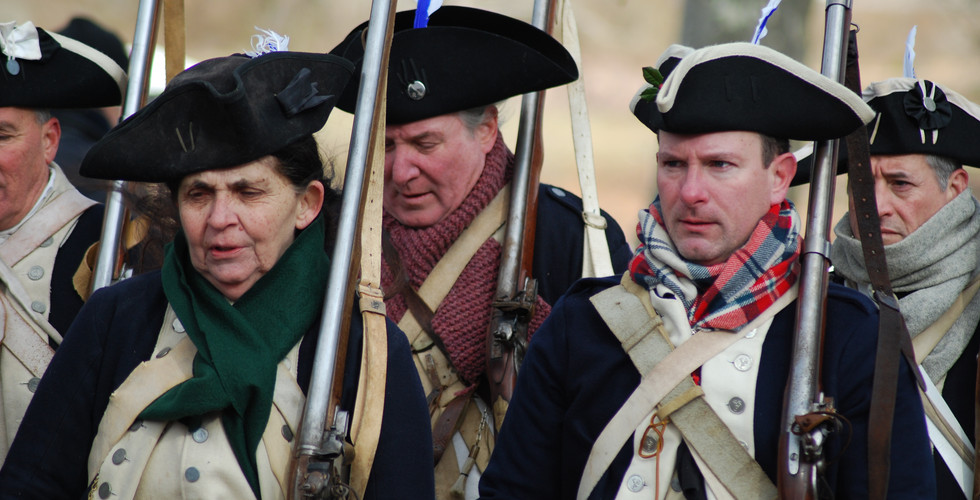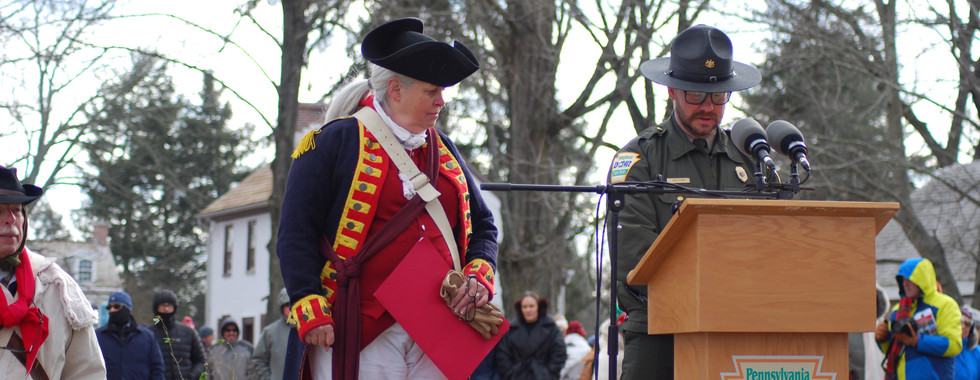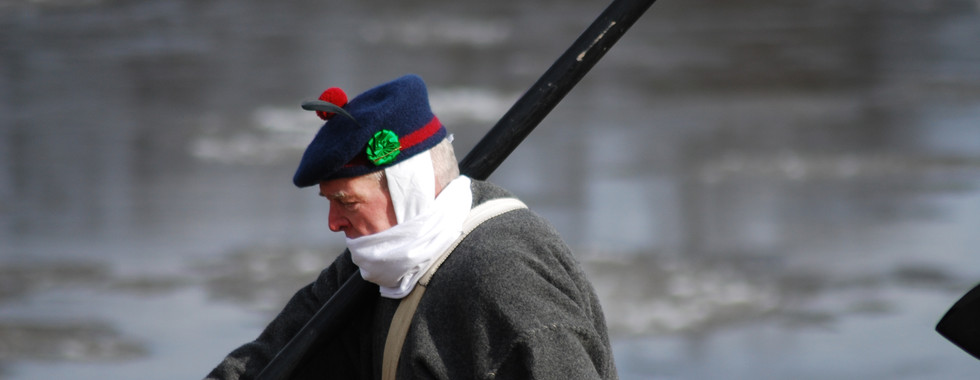The Crossing on Christmas; My Visit to Washington Crossing, Pennsylvania
- Kelan Amme

- Dec 27, 2022
- 5 min read

- George Washington (second from left) leads a march with his fellow Continental Army officers and soldiers. Photograph by Darin Amme.
Typically, most people spend their holidays staying inside, away from the cold, celebrating the holiday season with family, but on December 25th, 2022, Christmas day, my parents and I decided to take a trip to watch a reenactment of one of the turning points in the Revolutionary War. Every year for the past 60 years at the Washington Crossing Historic Park in Bucks County, Pennsylvania, park staff and volunteers work to immerse visitors in an experience straight out of the history books with the hopes of portraying the December 25th, 1776 crossing of the Delaware River by George Washington and the Continental Army.
Most of our public memory of the crossing is centered around this painting by Emanuel Leutze (c. 1851) that shows Washington standing valiantly on the front of his Durham boat with his fellow soldiers pushing the ice aside with their oars as a United States flag flutters behind them.
(1). Fig 1. Leutze, Emanuel, Washington Crossing the Delaware, Oil on canvas, 1851, The Metropolitan Museum of Art, New York City, USA, https://www.metmuseum.org/art/collection/search/11417.
From this moment in time, Washington and his army traveled to Trenton, New Jersey where they defeated the Hessian forces that were stationed there which led a following victory at the Battle of Princeton, ultimately boosting morale of U.S. troops and public as well as governmental support in the fight for independence.
The reenactment seeks to accomplish and epitomize the same emotions as Leutze's painting, however the weather on our visit seemed to be very similar to the one on Christmas morning 246 years ago. As we entered the park, we could see the ice flows streaming down the Delaware at a high rate of speed which unfortunately meant that the "crossing" portion of the reenactment would not happen today. Once we got out of the car and began walking along the path toward the river we realized how cold this experience was going to be. Even with this, I knew that I would have to stick it out to at least get some parallel with the men who fought and froze during this event in the eighteenth century. We then walked from the New Jersey side of the park down a winding path and across the single lane bridge towards the gathering of historic buildings.
A slideshow of images from the beginning of our walk towards the reenactment area. Photos by Darin Amme.
Since I am the social media manager for my the History Club at the university I attend, I

knew that I had to try and capture content for our Instagram to show our followers how we were still engaging with history over the winter break. So between weaving through the crowds of people and looking at the tens of hundreds of re-enactors, I was freezing my hands off taking pictures and videos of the event (as seen left). Speaking of the re-enactors, almost immediately we were put into a scene from a colonial army encampment as what seemed like hundreds of people in costume were walking around, talking to guests, marching in formation, playing fifes and drums, and warming themselves over the fire.
A collection of soldiers mingle around the park. Photos by Darin Amme. Please click on the photos to see the full size image as some of them are cropped out in the basic slideshow mode!
One of the more interesting parts of this event, at least to me, was seeing uniqueness of the costumes as well as the age range of the re-enactors. The parks program had a section that highlighted how long some of their volunteers and staff have served as re-enactors with two serving for over 50 years, five serving 40-49 years, and 15 serving 30-39 years. This did not include the many people who I saw who seemed to be around my age who also participated. Another interesting piece of information that came about at the crossing took place earlier in December and involved the inclusion of African American soldiers at an event on the New Jersey side of the river. Algernon Ward and his First Rhode Island Regiment were highlighted in an nj.com article on December 11th, 2022:
-------------
"The other main point of Sunday’s event was to remind or inform New Jerseyans and other Americans that, as in many key moments of the American Revolution, Black patriots played a role, crossing the river, marching down the old River Road (now known as Bear Tavern Road) and fighting with Washington and generals Nathanael Greene and John Sullivan in those pivotal battles..."
“We were not observers of history, we were participants - Algernon Ward” (2).
-------------
According to the article, the African American re-enactors were scheduled at the same time as the crossing and set up a camp on the New Jersey side of the river to show another example of colonial living conditions from the perspective African American regiments. As a college student who focuses on public history, it was great to see these kinds of efforts being taken to tell these stories in new ways. To read more about this story, see the sources section below.
Circling back, once we realized that the event was starting, we began to gather around the banks of the river to listen to the organizers speak about the history of the reenactment, which ultimately led to a full performance where Washington, his officers, other soldiers, musicians, and oarsmen marched in front of the boats and began recounting the events that took place on that cold Christmas Eve night and early Christmas morning. This included Washington reading a letter that was "sent" to him that explained how other Continental Army leaders would not be able to make the crossing as well as how other units failed to make it to their locations. Washington then walked amongst the troops explaining the reasons why they are fighting and what this victory will mean to the colonies. I really enjoyed this part as it reminded me of the quality of the reenactments that are performed in living history sites like Colonial Williamsburg where the audience is placed in the shoes (or lack their of) of the revolutionary military members. Once this part of the show was over, the re-enactors marched back toward the entrance to the park and we followed with them. As we were walking back across the bridge, we were able to watch the soldiers "fire" a replica cannon which was so loud it set off the alarm systems on cars parked across the river. It caught us off guard a couple of times as well. Overall, I thoroughly enjoyed the event and am excited to attend next year to hopefully catch a glimpse of the crossing.
More photographs from the reenactment. Photos by Darin Amme. Please click on each image to see them full size.
Sources:
Fig 1. Leutze, Emanuel, Washington Crossing the Delaware, Oil on canvas, 1851, The Metropolitan Museum of Art, New York City, USA, https://www.metmuseum.org/art/collection/search/11417.
Strunsky, Steve. "Here's what happened after Washington crossed the Delaware - with Black patriots on board." New Jersey.com. December 2022. See: https://www.nj.com/mercer/2022/12/heres-what-happened-after-washington-crossed-the-delaware-with-black-patriots-on-board.html.





























































































Comments